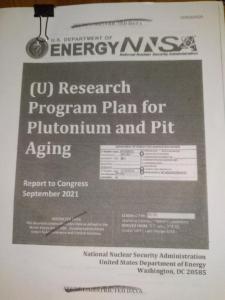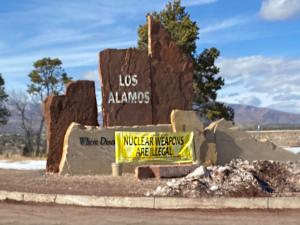U.S. DOE’s “Research Program Plan for Plutonium and Pit Aging,” delivered to Congress in September 2021, obtained tardy response to FOIA request by SRS Watch on April 4, 2024
Heavily Redacted Report to Congress, Obtained via Tardy FOIA Response by DOE’s National Nuclear Security Administration, Confirms Plutonium Aging Research Delay
— Tom Clements, Director, SRS Watch
COLUMBIA, SC, US, April 17, 2024 /EINPresswire.com/ — Nearly three years after filing a Freedom of Information Act request, the public interest group Savannah River Site Watch has finally received the National Nuclear Security Administration’s (NNSA’s) congressionally-required “Research Program Plan for Plutonium and Pit Aging.” However, the document is 40% blacked out, including references and acronyms. Plutonium “pits” are the radioactive cores of all U.S. nuclear weapons. The NNSA claims that potential aging effects are justification for a ~$60 billion program to expand production. However, the Plan fails to show that aging is a current problem. To the contrary, it demonstrates that NNSA is delaying urgently needed updated plutonium pit aging research.
In 2006 independent scientific experts known as the JASONs concluded that plutonium pits last at least 85 years without specifying an end date (the average pit age is now around 40 years). A 2012 follow-on study by the Lawrence Livermore nuclear weapons lab concluded:
“This continuing work shows that no unexpected aging issues are appearing in plutonium that has been accelerated to an equivalent of ~ 150 years of age. The results of this work are consistent with, and further reinforce, the Department of Energy Record of Decision to pursue a limited pit manufacturing capability in existing and planned facilities at Los Alamos instead of constructing a new, very large pit manufacturing facility…”
Since then NNSA has reversed itself. In 2018 the agency decided to pursue the simultaneous production of at least 30 pits per year at the Los Alamos National Laboratory (LANL) in northern New Mexico and at least 50 pits per year at the Savannah River Site (SRS) in South Carolina. Upgrades to plutonium facilities at LANL are slated to cost $8 billion over the next 5 years. The redundant Savannah River Plutonium Processing Facility in South Carolina will cost up to $25 billion, making it the second most expensive building in human history.
Hundreds of billions of taxpayers’ dollars and future international nuclear weapons policies are at stake. The Plan says, “This [pit aging] data will support the assessment of enduring stockpile systems and certification of ongoing and future [nuclear] warhead acquisition programs.” The U.S. is in the middle of a bow wave of exploding costs in a $2 trillion program to “modernize” nuclear weapons. According to the independent Government Accountability Office, the first 800 pits are for the deployment of multiple warheads on over budget Sentinel intercontinental ballistic missiles. This will be a seriously destabilizing step in the new nuclear arms race.
“NNSA should have done this research into plutonium pit aging a decade ago,” said Tom Clements, director of the public interest group Savannah River Site Watch. “The nuclear weapons agency should postpone its ~$60 billion plan to aggressively expand pit production until independently reviewed pit aging and pit reuse research has been completed. NNSA’s proposed research won’t be completed until 2030, by which time it will be spending more than $4 billion annually on unnecessary plutonium pit production. That is entirely backwards and must be corrected.”
In addition to SRS Watch, parallel FOIA requests were filed by Nuclear Watch New Mexico of Santa Fe, NM, and Tri-Valley Communities Against a Radioactive Environment in Livermore, CA. Three FOIA requests meet the threshold for a “Frequently Requested Document” that is legally required to be posted in NNSA’s E-FOIA Reading room. In addition, the groups intend to appeal many of the redactions which do not have clear national security justifications.
Scott Yundt, Attorney and TVC Executive Director, commented:
“The federal agency withheld the crux of the information we sought. NNSA has inappropriately relied on the blanket application of FOIA exemption 4, which “protects trade secrets and commercial or financial information… that is privileged or confidential.” Exemption 4 is not meant to cover up the results of a study Congress required to justify NNSA’s claimed need for new plutonium pits while spending many billions of taxpayer dollars. This information is clearly in the public’s interest. We will aggressively pursue our legal options to overturn these excessive redactions.”
Unredacted portions of NNSA’s Research Program Plan for Plutonium and Pit Aging do state:
“As a result of its radioactive nature, the plutonium pit undergoes self-irradiated damage throughout its volume. This constant decay alters the composition of, and deposits energy into, the plutonium metal. The accumulation of radiation damage over time, the deposition of energy, and the inception of impurities in the plutonium (products due to radiological decay) result in an aged material that may have different material properties than at origination.” (Page 3, parentheses in the original)
However, the Plan fails to mention that a unique characteristic of the plutonium isotope used in nuclear weapons (Pu-239) is that it quickly self-anneals and repairs its crystalline lattice structure after radiation damage as a result of competing processes in the metal. However, it is believed that 10% of plutonium-239 atoms do not self-heal, which would be a major concern over time. But there also appears to be longer term repair processes at work which NNSA has not publicly disclosed. “There seems to be a corrective mechanism that heals some of that change on longer time scales,” according to Dylan Spaulding, a physicist with the Union of Concerned Scientists who has worked at all three U.S. nuclear weapons laboratories. Raymond Jeanloz, who was a JASON member during its 2006 Pit Life study, agrees: “Something happens over longer time periods that makes [the metal] almost as good as new or maybe as good as new over time periods of 10 or 20 years or more.”
The 2021 Plan does note that, “In fiscal year (FY) 2023, a lifetime assessment using the updated and advanced age-aware physics models developed within the National Plutonium Aging Plan will be conducted.” (Page 4). This shows that NNSA has completed new pit life estimates but is leaving the American taxpayer in the dark over claimed need and massive cost overruns.
The full group news release, with links to footnotes is posted on the SRS Watch website.
Tom Clements
Savannah River Site Watch
+18032407268 ext.
email us here
Visit us on social media:
Facebook
Twitter
![]()
Originally published at https://www.einpresswire.com/article/704364133/nnsa-delays-urgent-plutonium-pit-aging-research-but-spends-tens-of-billions-on-nuclear-weapons-bomb-core-production






